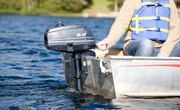
The trim setting of an outboard-powered boat determines how quickly it can get up to speed and how fast and comfortable the boat will cruise. Most large boats with high-powered outboards come with a powered trim mechanism so the trim can be adjusted while the boat is moving so the boat can get up to speed quickly and then adjust for the perfect ride. Smaller outboards have mechanical trim settings which can only be adjusted while the boat is stationary. The ideal adjustment for them is a compromise between fast starts and top speed.
Power Trim
Step 1
Start the boat’s motor and proceed at idle speed to a location where it’s safe and legal to power up the boat.
Step 2
Use the “trim down” button (typically located on the handle of the throttle/shift lever) to trim the motor to the fully down position. With the motor at idle, you can usually hear the whine of the hydraulic motor change when the fully down position is reached. Many boats come with a trim indicator gauge on the dashboard with a needle that moves up or down relative to the trim angle of the motor.
Step 3
Verify that everyone in the boat is seated then push the throttle/shift lever forward to power up the motor.
Step 4
Use the trim up button (also usually mounted on the throttle/shift lever) to slowly trim the motor up as the boat gains speed.
Step 5
Adjust the trim slightly up or down once the boat is at cruising speed. If the trim is adjusted too far up, the boat will begin to “porpoise” as the bow starts to bounce up and down across the water. If the trim is adjusted too far down, the bow will start to plow into the waves, noticeably slowing the boat.
Step 6
Continue adjusting if you speed up, slow down or encounter different currents or wave conditions.
Manual Trim
Step 1
Look for the trim setting mechanism just below the motor tilting hinge on the outboard. This is normally a series of holes in the motor and lower unit hinge brackets through which a stainless steel pin is inserted.
Step 2
Remove the stainless steel pin and reposition it into one of the adjustment holes near the center of the adjustment range before starting the motor.
Step 3
Start the motor then proceed at idle speed to a location where it’s safe and legal to power up the boat.
Step 4
Verify that all passengers in the boat are seated, then put the boat in gear and power up the engine.
Step 5
Observe the performance of the boat as it goes from full stop to full speed. Move the trim pin to different holes on the trim bracket to adjust the trim lower (moves the propeller forward and down) if the boat struggles to get up to speed; or to adjust the trim up (moving the propeller to the rear and up) if the boat powers up nicely but doesn't reach a decent speed. Keep adjusting and testing until a reasonable compromise in acceleration and speed is achieved.
Warnings
- Adjusting the trim, by using the motor, can only do so much. On medium-sized boats and larger, a set of trim tabs, separate from the motor, can help with both front to back trim, as well as enhance the lateral stability of the watercraft.
Tips
- The number of people or the load being carried in a boat will affect the needed trim. This is not a major concern in a power trim model, but in a manually trimmed boat, the operator should learn to gauge which different trim settings may be needed with various loads or wave conditions and make those adjustments before leaving the dock.
References
Tips
- The number of people or the load being carried in a boat will affect the needed trim. This is not a major concern in a power trim model, but in a manually trimmed boat, the operator should learn to gauge which different trim settings may be needed with various loads or wave conditions and make those adjustments before leaving the dock.
Warnings
- Adjusting the trim, by using the motor, can only do so much. On medium-sized boats and larger, a set of trim tabs, separate from the motor, can help with both front to back trim, as well as enhance the lateral stability of the watercraft.
Writer Bio
Mike Schoonveld has been writing since 1989 with magazine credits including "Outdoor Life," "Fur-Fish-Game," "The Rotarian" and numerous regional publications. Schoonveld earned a Master Captain License from the Coast Guard. He holds a Bachelor of Science in wildlife science from Purdue University.



